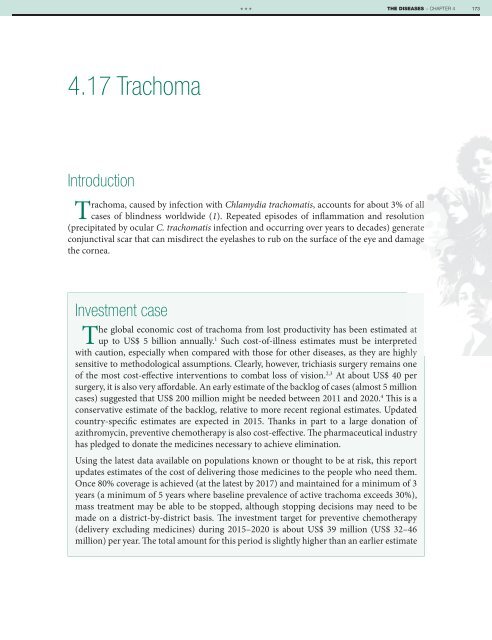1A9bnbK
1A9bnbK
1A9bnbK
You also want an ePaper? Increase the reach of your titles
YUMPU automatically turns print PDFs into web optimized ePapers that Google loves.
***<br />
THE DISEASES − CHAPTER 4<br />
173<br />
4.17 Trachoma<br />
Introduction<br />
Trachoma, caused by infection with Chlamydia trachomatis, accounts for about 3% of all<br />
cases of blindness worldwide (1). Repeated episodes of inflammation and resolution<br />
(precipitated by ocular C. trachomatis infection and occurring over years to decades) generate erate<br />
conjunctival scar that can misdirect the eyelashes to rub on the surface of the eye and damage<br />
the cornea.<br />
Investment case<br />
The global economic cost of trachoma from lost productivity has been estimated at<br />
up to US$ 5 billion annually. 1 Such cost-of-illness estimates must be interpreted ted<br />
with caution, especially when compared with those for other diseases, as they are highly hly<br />
sensitive to methodological assumptions. Clearly, however, trichiasis surgery remains one<br />
of the most cost-effective interventions to combat loss of vision. 2,3 At about US$ 40 per<br />
surgery, it is also very affordable. An early estimate of the backlog of cases (almost 5 million<br />
cases) suggested that US$ 200 million might be needed between 2011 and 2020. 4 This is a<br />
conservative estimate of the backlog, relative to more recent regional estimates. Updated<br />
country-specific estimates are expected in 2015. Thanks in part to a large donation of<br />
azithromycin, preventive chemotherapy is also cost-effective. The pharmaceutical industry<br />
has pledged to donate the medicines necessary to achieve elimination.<br />
Using the latest data available on populations known or thought to be at risk, this report<br />
updates estimates of the cost of delivering those medicines to the people who need them.<br />
Once 80% coverage is achieved (at the latest by 2017) and maintained for a minimum of 3<br />
years (a minimum of 5 years where baseline prevalence of active trachoma exceeds 30%),<br />
mass treatment may be able to be stopped, although stopping decisions may need to be<br />
made on a district-by-district basis. The investment target for preventive chemotherapy<br />
(delivery excluding medicines) during 2015–2020 is about US$ 39 million (US$ 32–46<br />
million) per year. The total amount for this period is slightly higher than an earlier estimate


